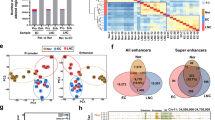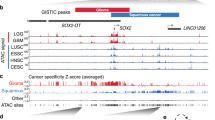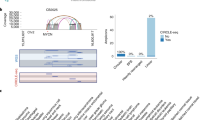Abstract
Whole-genome analysis approaches are identifying recurrent cancer-associated somatic alterations in noncoding DNA regions. We combined somatic copy number analysis of 12 tumor types with tissue-specific epigenetic profiling to identify significant regions of focal amplification harboring super-enhancers. Copy number gains of noncoding regions harboring super-enhancers near KLF5, USP12, PARD6B and MYC are associated with overexpression of these cancer-related genes. We show that two distinct focal amplifications of super-enhancers 3′ to MYC in lung adenocarcinoma (MYC-LASE) and endometrial carcinoma (MYC-ECSE) are physically associated with the MYC promoter and correlate with MYC overexpression. CRISPR/Cas9-mediated repression or deletion of a constituent enhancer within the MYC-LASE region led to significant reductions in the expression of MYC and its target genes and to the impairment of anchorage-independent and clonogenic growth, consistent with an oncogenic function. Our results suggest that genomic amplification of super-enhancers represents a common mechanism to activate cancer driver genes in multiple cancer types.
This is a preview of subscription content, access via your institution
Access options
Subscribe to this journal
Receive 12 print issues and online access
$209.00 per year
only $17.42 per issue
Buy this article
- Purchase on Springer Link
- Instant access to full article PDF
Prices may be subject to local taxes which are calculated during checkout






Similar content being viewed by others
References
Stratton, M.R., Campbell, P.J. & Futreal, P.A. The cancer genome. Nature 458, 719–724 (2009).
Beroukhim, R. et al. The landscape of somatic copy-number alteration across human cancers. Nature 463, 899–905 (2010).
Bignell, G.R. et al. Signatures of mutation and selection in the cancer genome. Nature 463, 893–898 (2010).
Stephens, P.J. et al. Complex landscapes of somatic rearrangement in human breast cancer genomes. Nature 462, 1005–1010 (2009).
Weir, B.A. et al. Characterizing the cancer genome in lung adenocarcinoma. Nature 450, 893–898 (2007).
Cancer Genome Atlas Research Network. Comprehensive molecular profiling of lung adenocarcinoma. Nature 511, 543–550 (2014).
Cancer Genome Atlas Research Network. Comprehensive genomic characterization of squamous cell lung cancers. Nature 489, 519 525 (2012).
Xue, W. et al. A cluster of cooperating tumor-suppressor gene candidates in chromosomal deletions. Proc. Natl. Acad. Sci. USA 109, 8212–8217 (2012).
Ong, C.-T. & Corces, V.G. Enhancer function: new insights into the regulation of tissue-specific gene expression. Nat. Rev. Genet. 12, 283–293 (2011).
Graf, T. & Enver, T. Forcing cells to change lineages. Nature 462, 587–594 (2009).
Xie, W. & Ren, B. Developmental biology. Enhancing pluripotency and lineage specification. Science 341, 245–247 (2013).
Bulger, M. & Groudine, M. Functional and mechanistic diversity of distal transcription enhancers. Cell 144, 327–339 (2011).
Lupien, M. et al. FoxA1 translates epigenetic signatures into enhancer-driven lineage-specific transcription. Cell 132, 958–970 (2008).
Visel, A. et al. ChIP-seq accurately predicts tissue-specific activity of enhancers. Nature 457, 854–858 (2009).
Heintzman, N.D. et al. Distinct and predictive chromatin signatures of transcriptional promoters and enhancers in the human genome. Nat. Genet. 39, 311–318 (2007).
Heintzman, N.D. et al. Histone modifications at human enhancers reflect global cell-type-specific gene expression. Nature 459, 108–112 (2009).
Creyghton, M.P. et al. Histone H3K27ac separates active from poised enhancers and predicts developmental state. Proc. Natl. Acad. Sci. USA 107, 21931–21936 (2010).
Ernst, J. et al. Mapping and analysis of chromatin state dynamics in nine human cell types. Nature 473, 43–49 (2011).
Thurman, R.E. et al. The accessible chromatin landscape of the human genome. Nature 489, 75–82 (2012).
ENCODE Project Consortium. An integrated encyclopedia of DNA elements in the human genome. Nature 489, 57–74 (2012).
Roadmap Epigenomics Consortium. Integrative analysis of 111 reference human epigenomes. Nature 518, 317–330 (2015).
Hnisz, D. et al. Super-enhancers in the control of cell identity and disease. Cell 155, 934–947 (2013).
Pott, S. & Lieb, J.D. What are super-enhancers? Nat. Genet. 47, 8–12 (2015).
Lovén, J. et al. Selective inhibition of tumor oncogenes by disruption of super-enhancers. Cell 153, 320–334 (2013).
Shi, J. et al. Role of SWI/SNF in acute leukemia maintenance and enhancer-mediated Myc regulation. Genes Dev. 27, 2648–2662 (2013).
Northcott, P.A. et al. Enhancer hijacking activates GFI1 family oncogenes in medulloblastoma. Nature 511, 428–434 (2014).
Mansour, M.R. et al. Oncogene regulation. An oncogenic super-enhancer formed through somatic mutation of a noncoding intergenic element. Science 346, 1373–1377 (2014).
Gröschel, S. et al. A single oncogenic enhancer rearrangement causes concomitant EVI1 and GATA2 deregulation in leukemia. Cell 157, 369–381 (2014).
Herranz, D. et al. A NOTCH1-driven MYC enhancer promotes T cell development, transformation and acute lymphoblastic leukemia. Nat. Med. 20, 1130–1137 (2014).
Mermel, C.H. et al. GISTIC2.0 facilitates sensitive and confident localization of the targets of focal somatic copy-number alteration in human cancers. Genome Biol. 12, R41 (2011).
Akhtar-Zaidi, B. et al. Epigenomic enhancer profiling defines a signature of colon cancer. Science 336, 736–739 (2012).
Whyte, W.A. et al. Master transcription factors and mediator establish super-enhancers at key cell identity genes. Cell 153, 307–319 (2013).
Burska, U.L. et al. Deubiquitinating enzyme Usp12 is a novel co-activator of the androgen receptor. J. Biol. Chem. 288, 32641–32650 (2013).
Qiu, R.-G., Abo, A. & Steven Martin, G. A human homolog of the C. elegans polarity determinant Par-6 links Rac and Cdc42 to PKCζ signaling and cell transformation. Curr. Biol. 10, 697–707 (2000).
Barretina, J. et al. The Cancer Cell Line Encyclopedia enables predictive modelling of anticancer drug sensitivity. Nature 483, 603–607 (2012).
Imielinski, M. et al. Mapping the hallmarks of lung adenocarcinoma with massively parallel sequencing. Cell 150, 1107–1120 (2012).
Kagey, M.H. et al. Mediator and cohesin connect gene expression and chromatin architecture. Nature 467, 430–435 (2010).
Deng, W. et al. Controlling long-range genomic interactions at a native locus by targeted tethering of a looping factor. Cell 149, 1233–1244 (2012).
Bailey, S.D. et al. ZNF143 provides sequence specificity to secure chromatin interactions at gene promoters. Nat. Commun. 2, 6186 (2015).
Wang, J. et al. Sequence features and chromatin structure around the genomic regions bound by 119 human transcription factors. Genome Res. 22, 1798–1812 (2012).
Gilbert, L.A. et al. CRISPR-mediated modular RNA-guided regulation of transcription in eukaryotes. Cell 154, 442–451 (2013).
Kearns, N.A. et al. Functional annotation of native enhancers with a Cas9–histone demethylase fusion. Nat. Methods 12, 401–403 (2015).
Schlosser, I. et al. Dissection of transcriptional programmes in response to serum and c-Myc in a human B-cell line. Oncogene 24, 520–524 (2005).
Coller, H.A. et al. Expression analysis with oligonucleotide microarrays reveals that MYC regulates genes involved in growth, cell cycle, signaling, and adhesion. Proc. Natl. Acad. Sci. USA 97, 3260–3265 (2000).
Zeller, K.I., Jegga, A.G., Aronow, B.J., O'Donnell, K.A. & Dang, C.V. An integrated database of genes responsive to the Myc oncogenic transcription factor: identification of direct genomic targets. Genome Biol. 4, R69 (2003).
Schuhmacher, M. et al. The transcriptional program of a human B cell line in response to Myc. Nucleic Acids Res. 29, 397–406 (2001).
Subramanian, A. et al. Gene set enrichment analysis: a knowledge-based approach for interpreting genome-wide expression profiles. Proc. Natl. Acad. Sci. USA 102, 15545–15550 (2005).
Battey, J. et al. The human c-myc oncogene: structural consequences of translocation into the IgH locus in Burkitt lymphoma. Cell 34, 779–787 (1983).
Francis, J.M. et al. EGFR variant heterogeneity in glioblastoma resolved through single-nucleus sequencing. Cancer Discov. 4, 956–971 (2014).
Cowper-Sal lari, R. et al. Breast cancer risk-associated SNPs modulate the affinity of chromatin for FOXA1 and alter gene expression. Nat. Genet. 44, 1191–1198 (2012).
Zhang, X., Cowper-Sal lari, R., Bailey, S.D., Moore, J.H. & Lupien, M. Integrative functional genomics identifies an enhancer looping to the SOX9 gene disrupted by the 17q24.3 prostate cancer risk locus. Genome Res. 22, 1437–1446 (2012).
Li, H. & Durbin, R. Fast and accurate short read alignment with Burrows-Wheeler transform. Bioinformatics 25, 1754–1760 (2009).
Zhang, Y. et al. Model-based analysis of ChIP-Seq (MACS). Genome Biol. 9, R137 (2008).
Sanjana, N.E., Shalem, O. & Zhang, F. Improved vectors and genome-wide libraries for CRISPR screening. Nat. Methods 11, 783–784 (2014).
Acknowledgements
We thank G. Ha and other members of the Meyerson laboratory for discussions. We acknowledge support from US Department of Defense grant W81XWH-12-1-0269 (M.M.), National Cancer Institute grant 1R35CA197568 (M.M.) and the American Cancer Society Research Professorship (M.M.). X.Z. is supported by the Lung Cancer Research Foundation and the American Association for Cancer Research–John and Elizabeth Leonard Family Foundation Basic Cancer Research Fellowship. P.S.C. is supported by a fellowship from the International Association for the Study of Lung Cancer and National Cancer Institute grant 1F32CA180662.
Author information
Authors and Affiliations
Contributions
X.Z., P.S.C., J.M.F. and M.M. designed the research and wrote the manuscript with input from the other authors. X.Z., P.S.C., J.M.F. and H.W. conducted the biological assays, and X.Z., P.S.C., J.M.F., M.I. and A.D.C. conducted the computational analysis.
Corresponding author
Ethics declarations
Competing interests
M.M. and A.D.C. have received a commercial research grant from Bayer.
Integrated supplementary information
Supplementary Figure 1 The expression level of genes in tumors with somatic focal amplification of each super-enhancer versus tumors without this focal amplification.
Genes that are expressed and closest to each amplification were analyzed. Box plot: middle bar, median; lower and upper box limits, 25th and 75th percentiles, respectively; whiskers, min and max values. The P value is derived from a t test: **P ≤ 0.01, ***P ≤ 0.001.
Supplementary Figure 2 GISTIC peak identified on chromosome 13q from esophageal carcinomas.
The H3K27ac ChIP-seq profile from esophageal cells is presented. Super-enhancers are also indicated. Expression level of KLF5 in tumors with and without amplified KLF5-ESSE (KLF5 esophageal carcinoma super-enhancer). The P value is derived from a t test.
Supplementary Figure 3 A focally amplified region (MYC-LASE) in lung adenocarcinomas is part of a super-enhancer.
(a) Copy number amplification of the noncoding region ~450 kb 3′ to MYC in lung adenocarcinoma primary tumors from TCGA (n = 11; sample IDs are listed in Supplementary Table 3) and (b) lung adenocarcinoma cell lines (NCI-H2009, HCC78, HOP92 and NCI-H358). Red lines represent relative focal amplification regions identified from each sample. The focal amplification peak called by GISTIC is highlighted. (c) Whole-genome sequencing rearrangement analysis of two lung adenocarcinoma tumors (sample IDs in Supplementary Table 3) identify tandem duplications, indicated by the red curves, as detected by the JaBbA structural rearrangement algorithm (Imielinski et al., in preparation). ChIP-seq profile of H3K27ac and super-enhancer (SE) regions in (d) A549, NCI-H358, NCI-H2009 and (e) HCC95 and NCI-H2171 cells. Thin bars above the ChIP-seq signal represent super-enhancers that are called by the ROSE pipeline. LUAD, lung adenocarcinomas; SqCC, squamous cell lung carcinomas; Small cell, small cell lung cancer.
Supplementary Figure 5 Cancer type–specific enhancer activity of the super-enhancer region.
(a) ChIP-seq profile of H3K27ac at the MYC locus. No enrichment of H3K27ac is detectable at the MYC-LASE region for HEK293 cells. (b) Luciferase reporter assay (n = 3) of the five constituent enhancers, e1–e5, in A549 lung adenocarcinoma cells and HEK293 cells. The P value is derived from a t test: **P ≤ 0.01, ***P ≤ 0.001.
Supplementary Figure 6 siRNA silencing of NFE2L2 and CEBPB in A549 cells.
The P value is derived from a t test (n = 3): **P ≤ 0.01, ***P ≤ 0.001.
Supplementary Figure 7 RNA-seq results in NCI-H2009 cells with and without KRAB-dCas9–mediated e3 enhancer repression.
Blue dots represent genes that are significantly differentially expressed (>25%) after e3 enhancer repression. Negative-control (NC) includes sg-Empty and sg-Control, while KRAB includes sg-e3KRAB 1 and sg-e3KRAB 2. RPKM mean indicates the mean expression levels (RPKM) normalized to the negative-control samples.
Supplementary Figure 8 KRAB-dCas9 fusion–mediated repression of the e3 enhancer in NCI-H2009 cells.
KRAB-dCas9 fusion–mediated repression of the e3 enhancer in NCI-H2009 cells leads to a significant reduction in cellular transformation efficiency as measured by anchorage-independent growth assay (a) and cellular proliferation rate as measured by clonogenic growth assay (b). Representative images are shown.
Supplementary Figure 9 CRISPR/Cas9-mediated deletion of the e3 enhancer in NCI-H2009 cells.
CRISPR/Cas9-mediated deletion of the e3 enhancer in NCI-H2009 cells leads to a significant reduction in cellular transformation efficiency as measured by anchorage-independent growth assay (a) and cellular proliferation rate as measured by clonogenic growth assay (b). Representative images are shown.
Supplementary information
Supplementary Text and Figures
Supplementary Figures 1–9. (PDF 1004 kb)
Supplementary Table 1: Pan-cancer copy number alteration analysis.
The number of noncoding focal amplification peaks identified and H3K27ac ChIP-seq data availability are highlighted in each tumor type. (XLSX 69 kb)
Supplementary Table 2: Accession numbers for public data sets used in the study.
A list of accession numbers for ENCODE data, Roadmap project data and other public data sets that were used in the study. (XLSX 44 kb)
Supplementary Table 3: Primers used in the study.
A list of PCR primers and CRISPR sgRNA sequences that were used in the study. (XLSX 13 kb)
Rights and permissions
About this article
Cite this article
Zhang, X., Choi, P., Francis, J. et al. Identification of focally amplified lineage-specific super-enhancers in human epithelial cancers. Nat Genet 48, 176–182 (2016). https://doi.org/10.1038/ng.3470
Received:
Accepted:
Published:
Issue Date:
DOI: https://doi.org/10.1038/ng.3470
This article is cited by
-
Spotlights on ubiquitin-specific protease 12 (USP12) in diseases: from multifaceted roles to pathophysiological mechanisms
Journal of Translational Medicine (2023)
-
Super-enhancers complexes zoom in transcription in cancer
Journal of Experimental & Clinical Cancer Research (2023)
-
Superenhancers as master gene regulators and novel therapeutic targets in brain tumors
Experimental & Molecular Medicine (2023)
-
Amplifying gene expression with RNA-targeted therapeutics
Nature Reviews Drug Discovery (2023)
-
An ectopic enhancer restores CFTR expression through de novo chromatin looping
Gene Therapy (2023)



